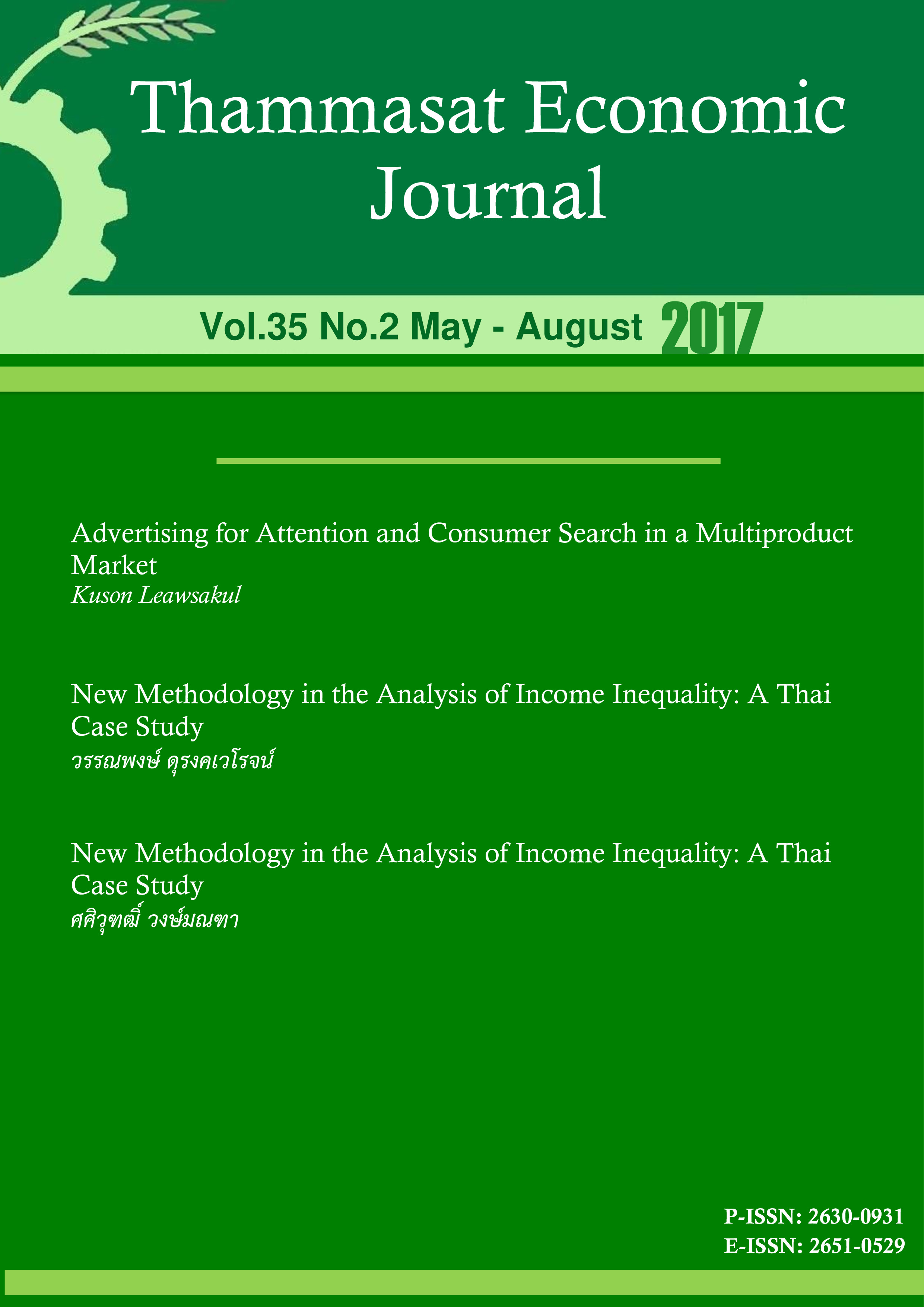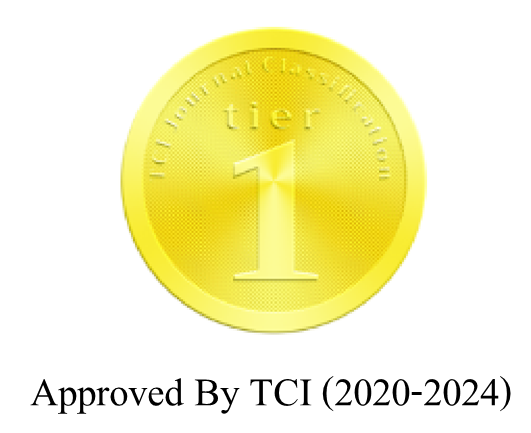The Determinants of Migrant Remittance Behavior: A Thai Case Study
Keywords:
Migration, Remittances, ThailandAbstract
Migrant remittances often serve as a major source of income and insurance for the receiving households. This paper uses the 2013 Socioeconomic Survey (SES) and historical annual rainfall data at the provincial level to examine the determinants of remittance behavior in Thailand, and test for the existence of four possible motives: altruism, exchange, insurance, and investment. Heckman’s (1979) two-step procedure is applied to estimate decisions to remit and the amount of remittances, accounting for selection bias. The results indicate that remittances are a part of implicit contract arrangements between migrants and household members. Regression results support a combination of four motives explaining migration and remittance behavior in Thailand. Major findings are: (1) Migrants from agricultural households or households with multiple migrants behave altruistically towards family members in origin households; (2) The amounts of remittances received increase with household income and assets, suggesting the importance of investment motives; and (3) Positive rainfall shocks decrease the propensity to migrate, but have no significant effect on the amounts remitted.
References
Agarwal, R. & Horowitz, W. (2002). Are international remittances altruism or insurance? Evidence from Guyana using Multiple-migrant Households. World Development 30(11), 2033-2044.
Amuedo-Dorantes, C. & Pozo, S. (2006). Remittances as insurance: Evidence form Mexican immigtants. Journal of Population Economics, 19(2), 227-254.
Becker, G.(1974). A Theory of social interactions. Journal of Political Economy, 82(6), 1063-1093.
Cameron, A. C., & Trivedi, P. K.. (2005). Microeconometrics: Methods and applications. Cambridge and New York: Cambridge University Press.
Cox, D. (1987). Motives for private transfers. Journal of Political Economy, 95(3), 508-546.
Cox, D., Ester, Z., & Jimemez, E. (1998). Motives for private transfers over the life cycle: An analytical framework and evidence for Peru. Journal of Development Economics, 55(1), 57-80.
De, B., Mueller, V., & Woldehanna, T. (2013). Motives to remit: Evidence from tracked internal migrants in Ethiopia. World Development, 50, 13-23.
Sadoulet, E., & De Janvry, A., & Lambert, S. (2002). The roles of destination, gender, and household composition in explaining remittances: An analysis for the Dominican Sierra. Journal of Development Economics, 68(2), 309-328.
Funkhouser, E. (1995). Remittances from international migration: A comparison of El Salvador and Nicaragua. Review of Economics and Statistics, 77(1), 137-146.
Garip, F. (2012). An intergrated analysis of migration and remittances: Modeling migration as a mechanism for selection. Population Research and Policy Review, 31(5), 637-663.
Gubert, F. (2002). Do migrants insure those who stay behind? Evidence from the Kayes area (Western Mali). Oxford Development Studies, 30(3), 267-287.
Harris, J. & Todaro, M. (1970). Migration, unemployment, and development: Two-sector analysis. American Economic Review, 60, 126-142.
Heckman, J. (1979). Sample selection bias as a specification error. Econometrica, 47(1), 153-161.
Hoddinott, J.(1994). A model of migration and remittances pp d to W st n K ny ” Oxford Economic Papers, 46(3), 459-476.
Lillard, L. & Willis,R.J. (1997). Motives for intergenerational transfers: Evidence from Malaysia. Demography, 34(1), 115-134.
Lucas, R. & Stark, O. (1985). Motivations to remit: Evidence from Botswanna. Journal of Political Economy, 93(5), 901-918.
McKay, A. & Deshingkar, P. (2014). Internal remittances and poverty: Further evidence from Africa and Asia. Working Paper No.12, Migration out of Poverty Research Programme Consortium. Sussex: University of Sussex.
Miller, D. & Paulson, A. (2007). Risk taking and the quality of informal insurance: Gambling and remittances in Thailand. Federal Reserve Bank of Chicago, Working Paper No.2007-01, 1-32.
National Statistical Office. (2013). Household socio-economic survey. Bangkok, Thailand: National Statistical Office (NSO).
National Statistical Office. (2014). Quarterly national labor force survey 1st Quarter.Bangkok, Thailand: National Statistical Office (NSO).
National Statistical Office. (2015). Statistics of rainfall at meteorology station: 2002-2013. Retrieved from https://service.nso.go.th/nso/web/statseries/statseries27.html.
Na Ranong, A. & Na Ranong, V. (2007). Impacts of Thailand's universal healthcare coverage scheme on health expenditures and poverty alleviation (in Thai). Bangkok, Thailand: Thailand Development Research Institite (TDRI).
Niimi, Y., Pham, T., & Reilly, B. (2009). Determinants of remittances: Recent evidence using data on internal migrants in Vietnam. Asian Economic Journal, 23(1), 19-39.
Osaki, K.. (2003). Migrate remittances in thailand: Economic necessity or social norm?. Journal of Population Research, 20(2), 203-222.
Paulson, A. (2000). Insurance motives for migration: Evidence from Thailand. Working Paper 2002, Evanson, IL. US: Kellogg School of Management, Northwestern University.
Paxson, C. (1992). Using weather variability to estimate the response of savings to transitory income in thailand. American Economic Review, 82(1), 15-33.
Phongpaichit, P. & Baker, C. (1995). Thailand: economy and politics. Kuala Lumpur: Oxford University Press.
Piracha, M. & Saraogi, A. (2011). Motivations for remittances: Evidence from Moldova. IZA Discussion Paper No.5467, Institue for the Study of Labor.
Poirine, B. (1997). A theory of remittances as an implicit family loan arrangement. World Development, 25(4), 589-611.
Rapoport, H. & Docquier, F. (2006). The economics of migrants' remittances, eds. by Kolm S. and Mercier J. in Handbook of Economics of Giving, Altruism, and Reciprocity, 1138-1195. Amsterdam: North Holland.
Stark, O. & Bloom, D. (1985). The new economics of labor migration. American Economic Review, 75, 173-178.
Stark, O. & Lucas, R. (1988). Migration, remittances, and the family. Economic Development and Cultural Change, 36(3), 465-481.
Taylor, J.E. (1999). The new economics of labor migration and the role of remittances in the migration process. International Migration, 37(1), 63-88.
Techasunthornwat, C. (2014). Reinvestigating remittance motivations, based on Thailand's socioeconomic survey. Master Thesis, Faculty of Economics, Thammasat University.
Todaro, M. (1969). A model of migration and urban unemployment in less-developed countries. American Economic Review, 59, 138-148.
Vanwey, L. (2004). Altruistic & contractual remittances between male and female migrants and households in rural Thailand. Demography, 41(4), 739-756.
World Bank. (2011). Migration & Remittances Factbook 2011. Washington, D.C.: World Bank.
World Bank. (2016). Migration & Remittances Factbook 2016. Washington, D.C.: World Bank.
Xu, K., Evans, D., Carrin, G., & Aguilar-Rivera, A. (2005). Finance systems to reduce catastrophic health expenditure. Geneva: World Health Organization.
Yang, D. & Choi, H. (2007). Are remittances insurance? Evidence from rainfall shocks in the Philippines. World Bank Economic Review, 21(2), 219-248.







